Organisational Behaviour Report: Culture, Power, Teams, and Goals
VerifiedAdded on 2020/07/23
|14
|3905
|115
Report
AI Summary
This report provides an in-depth analysis of organisational behaviour, focusing on a case study of A David & Co Limited. It explores the influence of culture, power, and politics on employee behaviour, examining how these factors shape the workplace environment. The report delves into the importance of content and process theories in achieving organisational goals, with detailed explanations of motivational theories like Maslow's hierarchy, reinforcement, and expectancy theory. Furthermore, it differentiates between effective and ineffective teams, highlighting key characteristics such as open discussion, situational leadership, and a shared focus on common goals. The report aims to provide a comprehensive understanding of organisational behaviour principles and their practical application in a business setting, ultimately offering strategies for enhancing team performance and overall organisational effectiveness.
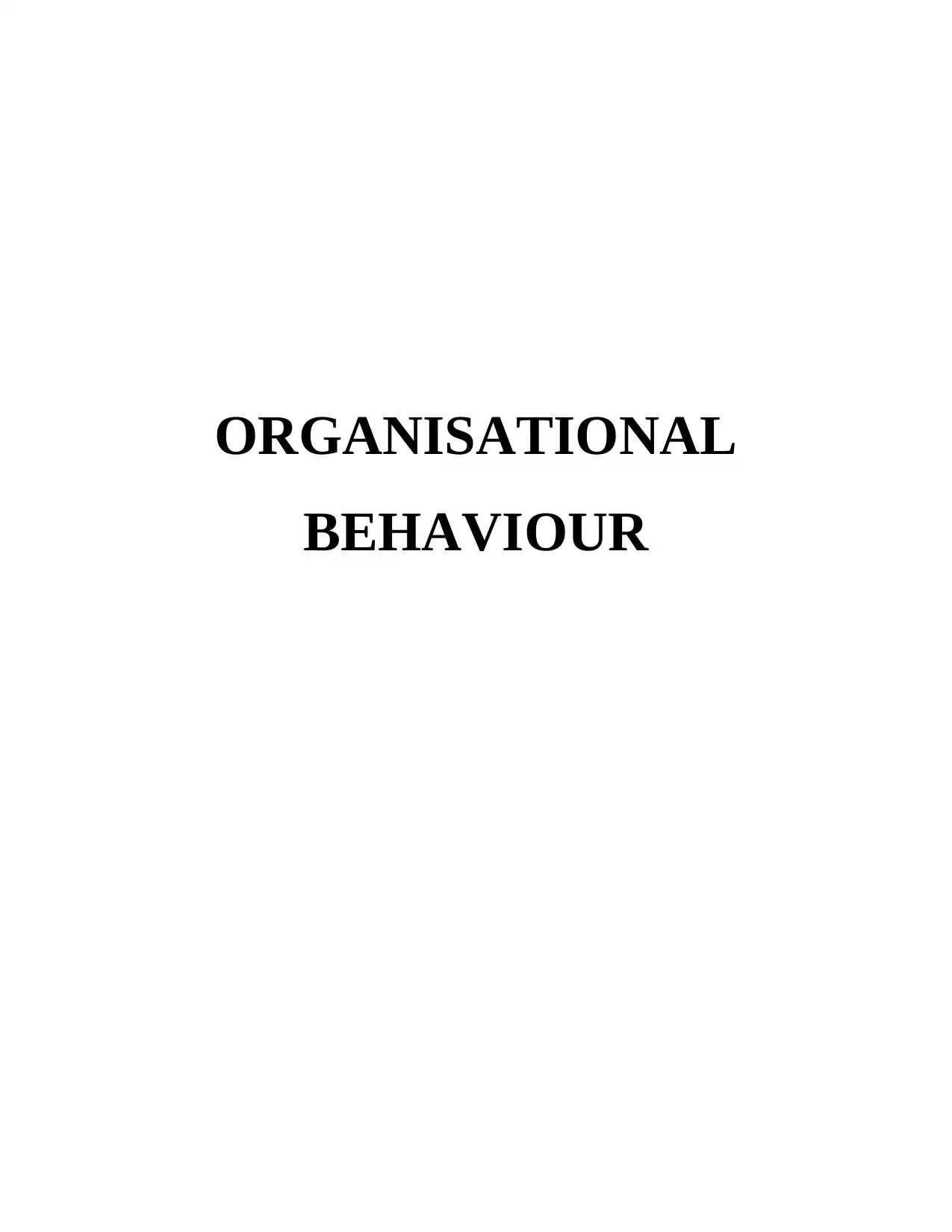
ORGANISATIONAL
BEHAVIOUR
BEHAVIOUR
Paraphrase This Document
Need a fresh take? Get an instant paraphrase of this document with our AI Paraphraser

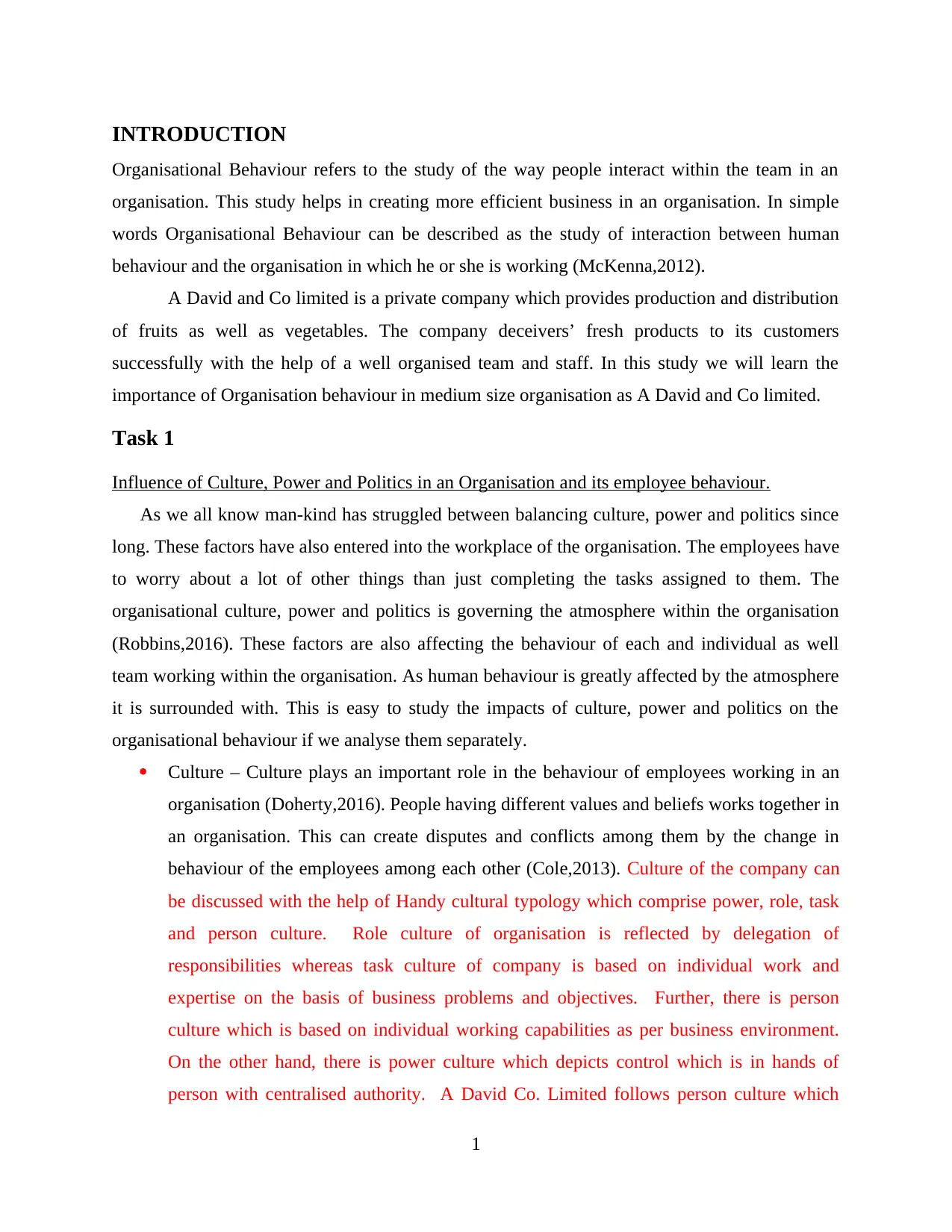
INTRODUCTION
Organisational Behaviour refers to the study of the way people interact within the team in an
organisation. This study helps in creating more efficient business in an organisation. In simple
words Organisational Behaviour can be described as the study of interaction between human
behaviour and the organisation in which he or she is working (McKenna,2012).
A David and Co limited is a private company which provides production and distribution
of fruits as well as vegetables. The company deceivers’ fresh products to its customers
successfully with the help of a well organised team and staff. In this study we will learn the
importance of Organisation behaviour in medium size organisation as A David and Co limited.
Task 1
Influence of Culture, Power and Politics in an Organisation and its employee behaviour.
As we all know man-kind has struggled between balancing culture, power and politics since
long. These factors have also entered into the workplace of the organisation. The employees have
to worry about a lot of other things than just completing the tasks assigned to them. The
organisational culture, power and politics is governing the atmosphere within the organisation
(Robbins,2016). These factors are also affecting the behaviour of each and individual as well
team working within the organisation. As human behaviour is greatly affected by the atmosphere
it is surrounded with. This is easy to study the impacts of culture, power and politics on the
organisational behaviour if we analyse them separately.
Culture – Culture plays an important role in the behaviour of employees working in an
organisation (Doherty,2016). People having different values and beliefs works together in
an organisation. This can create disputes and conflicts among them by the change in
behaviour of the employees among each other (Cole,2013). Culture of the company can
be discussed with the help of Handy cultural typology which comprise power, role, task
and person culture. Role culture of organisation is reflected by delegation of
responsibilities whereas task culture of company is based on individual work and
expertise on the basis of business problems and objectives. Further, there is person
culture which is based on individual working capabilities as per business environment.
On the other hand, there is power culture which depicts control which is in hands of
person with centralised authority. A David Co. Limited follows person culture which
1
Organisational Behaviour refers to the study of the way people interact within the team in an
organisation. This study helps in creating more efficient business in an organisation. In simple
words Organisational Behaviour can be described as the study of interaction between human
behaviour and the organisation in which he or she is working (McKenna,2012).
A David and Co limited is a private company which provides production and distribution
of fruits as well as vegetables. The company deceivers’ fresh products to its customers
successfully with the help of a well organised team and staff. In this study we will learn the
importance of Organisation behaviour in medium size organisation as A David and Co limited.
Task 1
Influence of Culture, Power and Politics in an Organisation and its employee behaviour.
As we all know man-kind has struggled between balancing culture, power and politics since
long. These factors have also entered into the workplace of the organisation. The employees have
to worry about a lot of other things than just completing the tasks assigned to them. The
organisational culture, power and politics is governing the atmosphere within the organisation
(Robbins,2016). These factors are also affecting the behaviour of each and individual as well
team working within the organisation. As human behaviour is greatly affected by the atmosphere
it is surrounded with. This is easy to study the impacts of culture, power and politics on the
organisational behaviour if we analyse them separately.
Culture – Culture plays an important role in the behaviour of employees working in an
organisation (Doherty,2016). People having different values and beliefs works together in
an organisation. This can create disputes and conflicts among them by the change in
behaviour of the employees among each other (Cole,2013). Culture of the company can
be discussed with the help of Handy cultural typology which comprise power, role, task
and person culture. Role culture of organisation is reflected by delegation of
responsibilities whereas task culture of company is based on individual work and
expertise on the basis of business problems and objectives. Further, there is person
culture which is based on individual working capabilities as per business environment.
On the other hand, there is power culture which depicts control which is in hands of
person with centralised authority. A David Co. Limited follows person culture which
1
⊘ This is a preview!⊘
Do you want full access?
Subscribe today to unlock all pages.

Trusted by 1+ million students worldwide
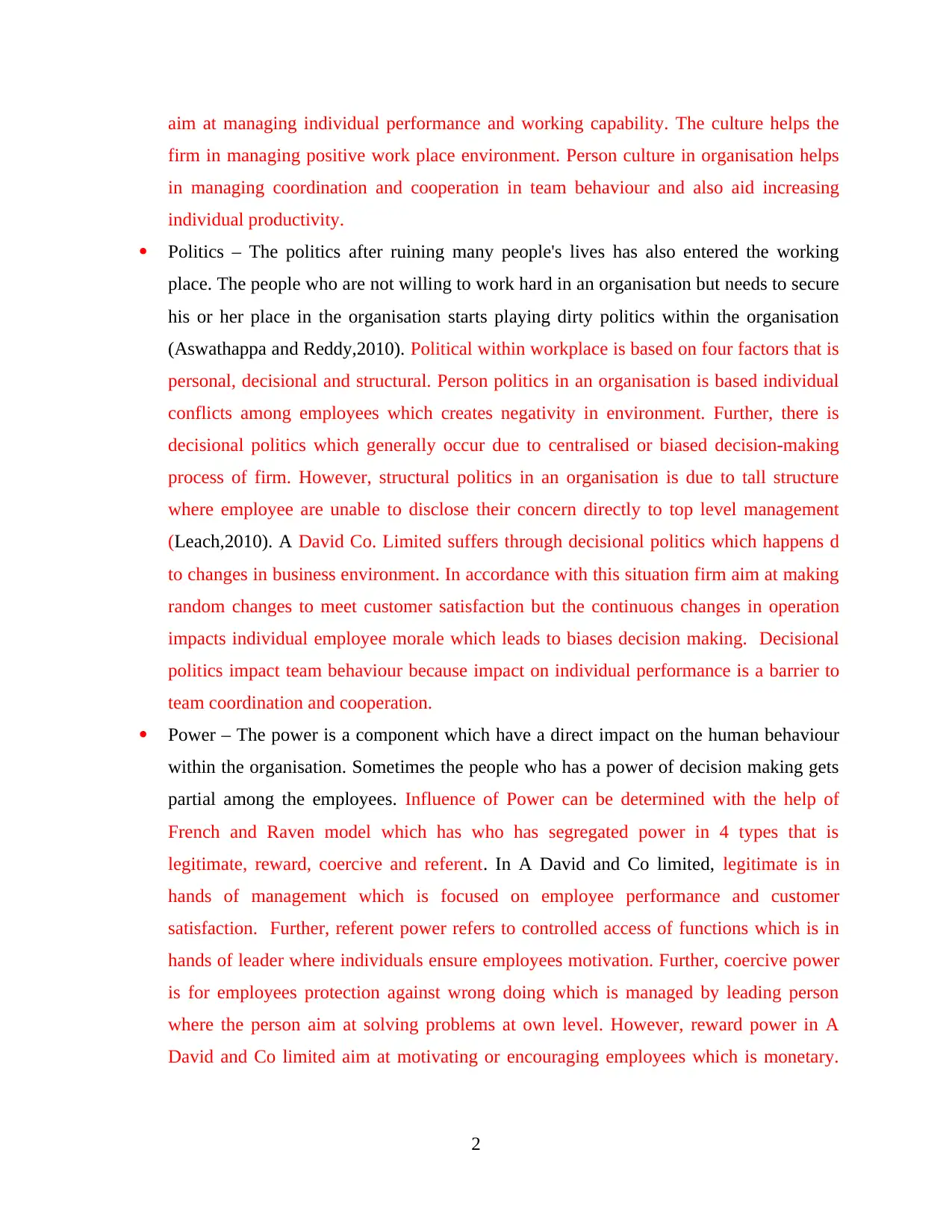
aim at managing individual performance and working capability. The culture helps the
firm in managing positive work place environment. Person culture in organisation helps
in managing coordination and cooperation in team behaviour and also aid increasing
individual productivity.
Politics – The politics after ruining many people's lives has also entered the working
place. The people who are not willing to work hard in an organisation but needs to secure
his or her place in the organisation starts playing dirty politics within the organisation
(Aswathappa and Reddy,2010). Political within workplace is based on four factors that is
personal, decisional and structural. Person politics in an organisation is based individual
conflicts among employees which creates negativity in environment. Further, there is
decisional politics which generally occur due to centralised or biased decision-making
process of firm. However, structural politics in an organisation is due to tall structure
where employee are unable to disclose their concern directly to top level management
(Leach,2010). A David Co. Limited suffers through decisional politics which happens d
to changes in business environment. In accordance with this situation firm aim at making
random changes to meet customer satisfaction but the continuous changes in operation
impacts individual employee morale which leads to biases decision making. Decisional
politics impact team behaviour because impact on individual performance is a barrier to
team coordination and cooperation.
Power – The power is a component which have a direct impact on the human behaviour
within the organisation. Sometimes the people who has a power of decision making gets
partial among the employees. Influence of Power can be determined with the help of
French and Raven model which has who has segregated power in 4 types that is
legitimate, reward, coercive and referent. In A David and Co limited, legitimate is in
hands of management which is focused on employee performance and customer
satisfaction. Further, referent power refers to controlled access of functions which is in
hands of leader where individuals ensure employees motivation. Further, coercive power
is for employees protection against wrong doing which is managed by leading person
where the person aim at solving problems at own level. However, reward power in A
David and Co limited aim at motivating or encouraging employees which is monetary.
2
firm in managing positive work place environment. Person culture in organisation helps
in managing coordination and cooperation in team behaviour and also aid increasing
individual productivity.
Politics – The politics after ruining many people's lives has also entered the working
place. The people who are not willing to work hard in an organisation but needs to secure
his or her place in the organisation starts playing dirty politics within the organisation
(Aswathappa and Reddy,2010). Political within workplace is based on four factors that is
personal, decisional and structural. Person politics in an organisation is based individual
conflicts among employees which creates negativity in environment. Further, there is
decisional politics which generally occur due to centralised or biased decision-making
process of firm. However, structural politics in an organisation is due to tall structure
where employee are unable to disclose their concern directly to top level management
(Leach,2010). A David Co. Limited suffers through decisional politics which happens d
to changes in business environment. In accordance with this situation firm aim at making
random changes to meet customer satisfaction but the continuous changes in operation
impacts individual employee morale which leads to biases decision making. Decisional
politics impact team behaviour because impact on individual performance is a barrier to
team coordination and cooperation.
Power – The power is a component which have a direct impact on the human behaviour
within the organisation. Sometimes the people who has a power of decision making gets
partial among the employees. Influence of Power can be determined with the help of
French and Raven model which has who has segregated power in 4 types that is
legitimate, reward, coercive and referent. In A David and Co limited, legitimate is in
hands of management which is focused on employee performance and customer
satisfaction. Further, referent power refers to controlled access of functions which is in
hands of leader where individuals ensure employees motivation. Further, coercive power
is for employees protection against wrong doing which is managed by leading person
where the person aim at solving problems at own level. However, reward power in A
David and Co limited aim at motivating or encouraging employees which is monetary.
2
Paraphrase This Document
Need a fresh take? Get an instant paraphrase of this document with our AI Paraphraser
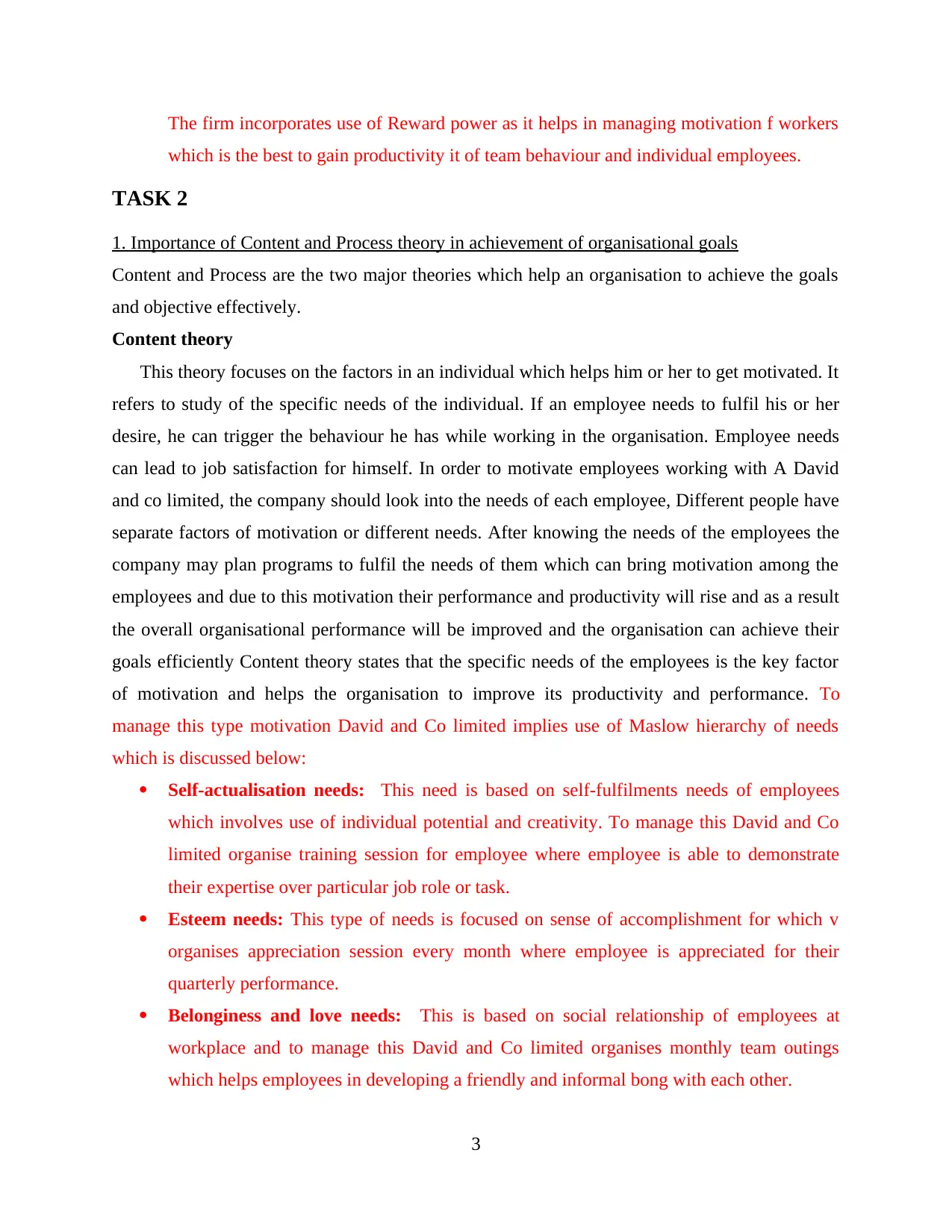
The firm incorporates use of Reward power as it helps in managing motivation f workers
which is the best to gain productivity it of team behaviour and individual employees.
TASK 2
1. Importance of Content and Process theory in achievement of organisational goals
Content and Process are the two major theories which help an organisation to achieve the goals
and objective effectively.
Content theory
This theory focuses on the factors in an individual which helps him or her to get motivated. It
refers to study of the specific needs of the individual. If an employee needs to fulfil his or her
desire, he can trigger the behaviour he has while working in the organisation. Employee needs
can lead to job satisfaction for himself. In order to motivate employees working with A David
and co limited, the company should look into the needs of each employee, Different people have
separate factors of motivation or different needs. After knowing the needs of the employees the
company may plan programs to fulfil the needs of them which can bring motivation among the
employees and due to this motivation their performance and productivity will rise and as a result
the overall organisational performance will be improved and the organisation can achieve their
goals efficiently Content theory states that the specific needs of the employees is the key factor
of motivation and helps the organisation to improve its productivity and performance. To
manage this type motivation David and Co limited implies use of Maslow hierarchy of needs
which is discussed below:
Self-actualisation needs: This need is based on self-fulfilments needs of employees
which involves use of individual potential and creativity. To manage this David and Co
limited organise training session for employee where employee is able to demonstrate
their expertise over particular job role or task.
Esteem needs: This type of needs is focused on sense of accomplishment for which v
organises appreciation session every month where employee is appreciated for their
quarterly performance.
Belonginess and love needs: This is based on social relationship of employees at
workplace and to manage this David and Co limited organises monthly team outings
which helps employees in developing a friendly and informal bong with each other.
3
which is the best to gain productivity it of team behaviour and individual employees.
TASK 2
1. Importance of Content and Process theory in achievement of organisational goals
Content and Process are the two major theories which help an organisation to achieve the goals
and objective effectively.
Content theory
This theory focuses on the factors in an individual which helps him or her to get motivated. It
refers to study of the specific needs of the individual. If an employee needs to fulfil his or her
desire, he can trigger the behaviour he has while working in the organisation. Employee needs
can lead to job satisfaction for himself. In order to motivate employees working with A David
and co limited, the company should look into the needs of each employee, Different people have
separate factors of motivation or different needs. After knowing the needs of the employees the
company may plan programs to fulfil the needs of them which can bring motivation among the
employees and due to this motivation their performance and productivity will rise and as a result
the overall organisational performance will be improved and the organisation can achieve their
goals efficiently Content theory states that the specific needs of the employees is the key factor
of motivation and helps the organisation to improve its productivity and performance. To
manage this type motivation David and Co limited implies use of Maslow hierarchy of needs
which is discussed below:
Self-actualisation needs: This need is based on self-fulfilments needs of employees
which involves use of individual potential and creativity. To manage this David and Co
limited organise training session for employee where employee is able to demonstrate
their expertise over particular job role or task.
Esteem needs: This type of needs is focused on sense of accomplishment for which v
organises appreciation session every month where employee is appreciated for their
quarterly performance.
Belonginess and love needs: This is based on social relationship of employees at
workplace and to manage this David and Co limited organises monthly team outings
which helps employees in developing a friendly and informal bong with each other.
3
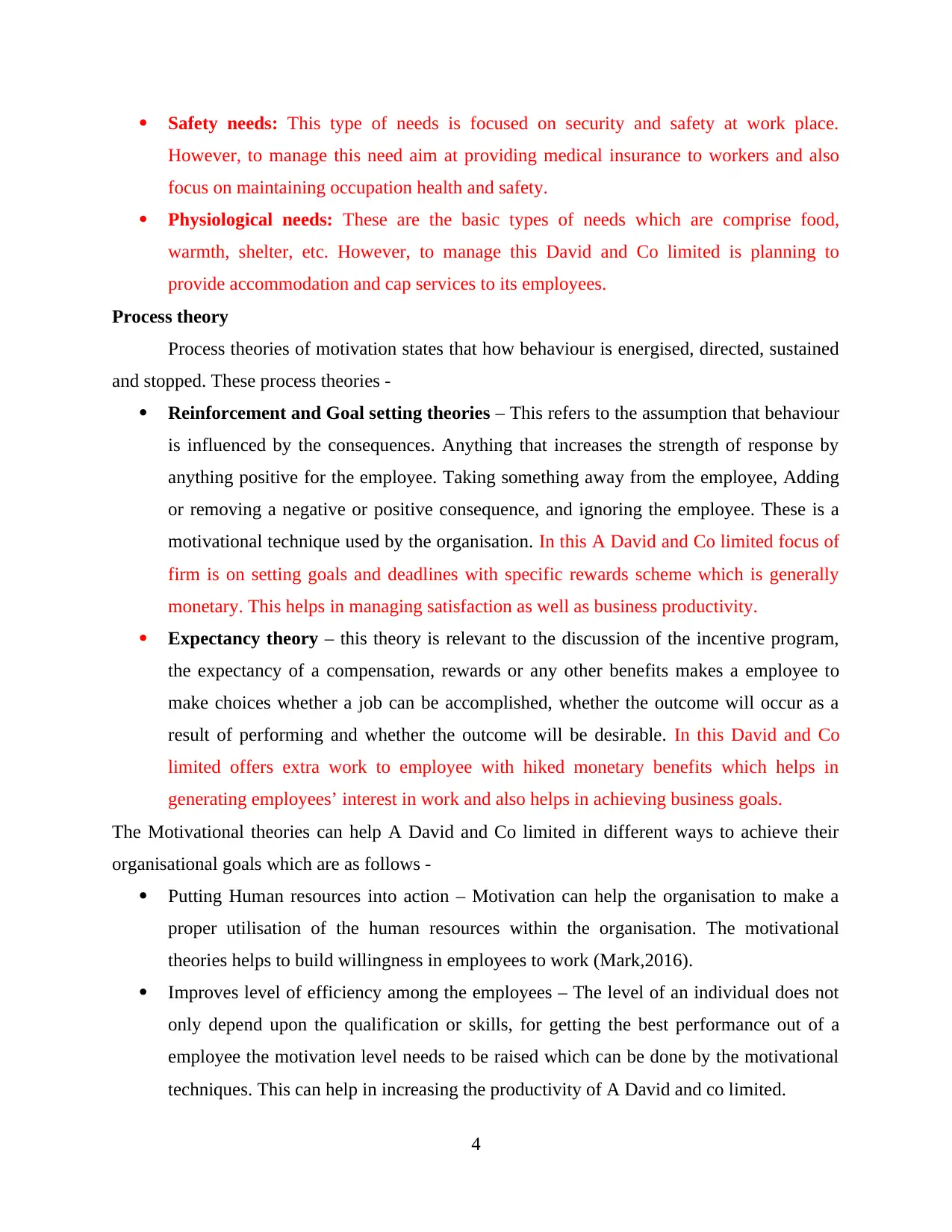
Safety needs: This type of needs is focused on security and safety at work place.
However, to manage this need aim at providing medical insurance to workers and also
focus on maintaining occupation health and safety.
Physiological needs: These are the basic types of needs which are comprise food,
warmth, shelter, etc. However, to manage this David and Co limited is planning to
provide accommodation and cap services to its employees.
Process theory
Process theories of motivation states that how behaviour is energised, directed, sustained
and stopped. These process theories -
Reinforcement and Goal setting theories – This refers to the assumption that behaviour
is influenced by the consequences. Anything that increases the strength of response by
anything positive for the employee. Taking something away from the employee, Adding
or removing a negative or positive consequence, and ignoring the employee. These is a
motivational technique used by the organisation. In this A David and Co limited focus of
firm is on setting goals and deadlines with specific rewards scheme which is generally
monetary. This helps in managing satisfaction as well as business productivity.
Expectancy theory – this theory is relevant to the discussion of the incentive program,
the expectancy of a compensation, rewards or any other benefits makes a employee to
make choices whether a job can be accomplished, whether the outcome will occur as a
result of performing and whether the outcome will be desirable. In this David and Co
limited offers extra work to employee with hiked monetary benefits which helps in
generating employees’ interest in work and also helps in achieving business goals.
The Motivational theories can help A David and Co limited in different ways to achieve their
organisational goals which are as follows -
Putting Human resources into action – Motivation can help the organisation to make a
proper utilisation of the human resources within the organisation. The motivational
theories helps to build willingness in employees to work (Mark,2016).
Improves level of efficiency among the employees – The level of an individual does not
only depend upon the qualification or skills, for getting the best performance out of a
employee the motivation level needs to be raised which can be done by the motivational
techniques. This can help in increasing the productivity of A David and co limited.
4
However, to manage this need aim at providing medical insurance to workers and also
focus on maintaining occupation health and safety.
Physiological needs: These are the basic types of needs which are comprise food,
warmth, shelter, etc. However, to manage this David and Co limited is planning to
provide accommodation and cap services to its employees.
Process theory
Process theories of motivation states that how behaviour is energised, directed, sustained
and stopped. These process theories -
Reinforcement and Goal setting theories – This refers to the assumption that behaviour
is influenced by the consequences. Anything that increases the strength of response by
anything positive for the employee. Taking something away from the employee, Adding
or removing a negative or positive consequence, and ignoring the employee. These is a
motivational technique used by the organisation. In this A David and Co limited focus of
firm is on setting goals and deadlines with specific rewards scheme which is generally
monetary. This helps in managing satisfaction as well as business productivity.
Expectancy theory – this theory is relevant to the discussion of the incentive program,
the expectancy of a compensation, rewards or any other benefits makes a employee to
make choices whether a job can be accomplished, whether the outcome will occur as a
result of performing and whether the outcome will be desirable. In this David and Co
limited offers extra work to employee with hiked monetary benefits which helps in
generating employees’ interest in work and also helps in achieving business goals.
The Motivational theories can help A David and Co limited in different ways to achieve their
organisational goals which are as follows -
Putting Human resources into action – Motivation can help the organisation to make a
proper utilisation of the human resources within the organisation. The motivational
theories helps to build willingness in employees to work (Mark,2016).
Improves level of efficiency among the employees – The level of an individual does not
only depend upon the qualification or skills, for getting the best performance out of a
employee the motivation level needs to be raised which can be done by the motivational
techniques. This can help in increasing the productivity of A David and co limited.
4
⊘ This is a preview!⊘
Do you want full access?
Subscribe today to unlock all pages.

Trusted by 1+ million students worldwide
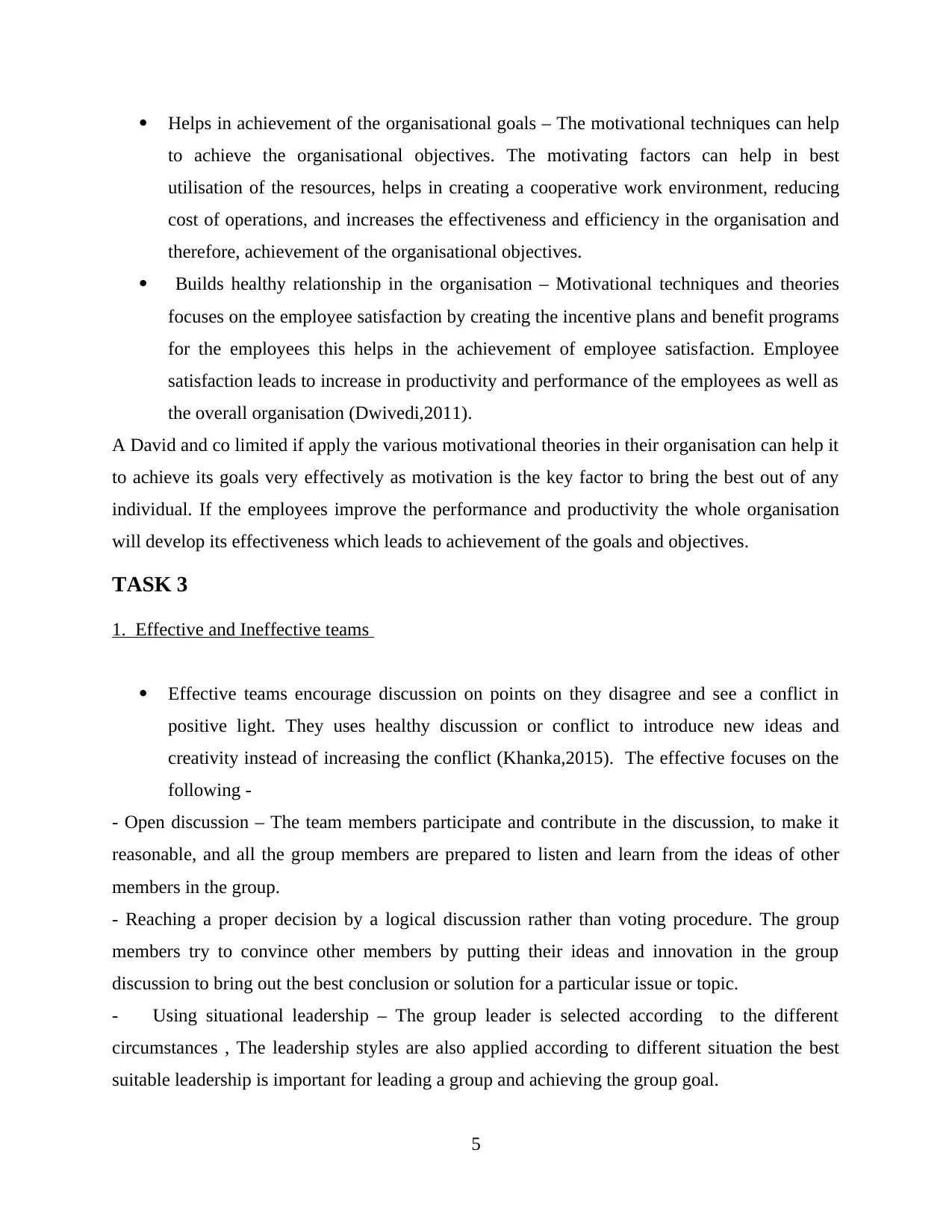
Helps in achievement of the organisational goals – The motivational techniques can help
to achieve the organisational objectives. The motivating factors can help in best
utilisation of the resources, helps in creating a cooperative work environment, reducing
cost of operations, and increases the effectiveness and efficiency in the organisation and
therefore, achievement of the organisational objectives.
Builds healthy relationship in the organisation – Motivational techniques and theories
focuses on the employee satisfaction by creating the incentive plans and benefit programs
for the employees this helps in the achievement of employee satisfaction. Employee
satisfaction leads to increase in productivity and performance of the employees as well as
the overall organisation (Dwivedi,2011).
A David and co limited if apply the various motivational theories in their organisation can help it
to achieve its goals very effectively as motivation is the key factor to bring the best out of any
individual. If the employees improve the performance and productivity the whole organisation
will develop its effectiveness which leads to achievement of the goals and objectives.
TASK 3
1. Effective and Ineffective teams
Effective teams encourage discussion on points on they disagree and see a conflict in
positive light. They uses healthy discussion or conflict to introduce new ideas and
creativity instead of increasing the conflict (Khanka,2015). The effective focuses on the
following -
- Open discussion – The team members participate and contribute in the discussion, to make it
reasonable, and all the group members are prepared to listen and learn from the ideas of other
members in the group.
- Reaching a proper decision by a logical discussion rather than voting procedure. The group
members try to convince other members by putting their ideas and innovation in the group
discussion to bring out the best conclusion or solution for a particular issue or topic.
- Using situational leadership – The group leader is selected according to the different
circumstances , The leadership styles are also applied according to different situation the best
suitable leadership is important for leading a group and achieving the group goal.
5
to achieve the organisational objectives. The motivating factors can help in best
utilisation of the resources, helps in creating a cooperative work environment, reducing
cost of operations, and increases the effectiveness and efficiency in the organisation and
therefore, achievement of the organisational objectives.
Builds healthy relationship in the organisation – Motivational techniques and theories
focuses on the employee satisfaction by creating the incentive plans and benefit programs
for the employees this helps in the achievement of employee satisfaction. Employee
satisfaction leads to increase in productivity and performance of the employees as well as
the overall organisation (Dwivedi,2011).
A David and co limited if apply the various motivational theories in their organisation can help it
to achieve its goals very effectively as motivation is the key factor to bring the best out of any
individual. If the employees improve the performance and productivity the whole organisation
will develop its effectiveness which leads to achievement of the goals and objectives.
TASK 3
1. Effective and Ineffective teams
Effective teams encourage discussion on points on they disagree and see a conflict in
positive light. They uses healthy discussion or conflict to introduce new ideas and
creativity instead of increasing the conflict (Khanka,2015). The effective focuses on the
following -
- Open discussion – The team members participate and contribute in the discussion, to make it
reasonable, and all the group members are prepared to listen and learn from the ideas of other
members in the group.
- Reaching a proper decision by a logical discussion rather than voting procedure. The group
members try to convince other members by putting their ideas and innovation in the group
discussion to bring out the best conclusion or solution for a particular issue or topic.
- Using situational leadership – The group leader is selected according to the different
circumstances , The leadership styles are also applied according to different situation the best
suitable leadership is important for leading a group and achieving the group goal.
5
Paraphrase This Document
Need a fresh take? Get an instant paraphrase of this document with our AI Paraphraser
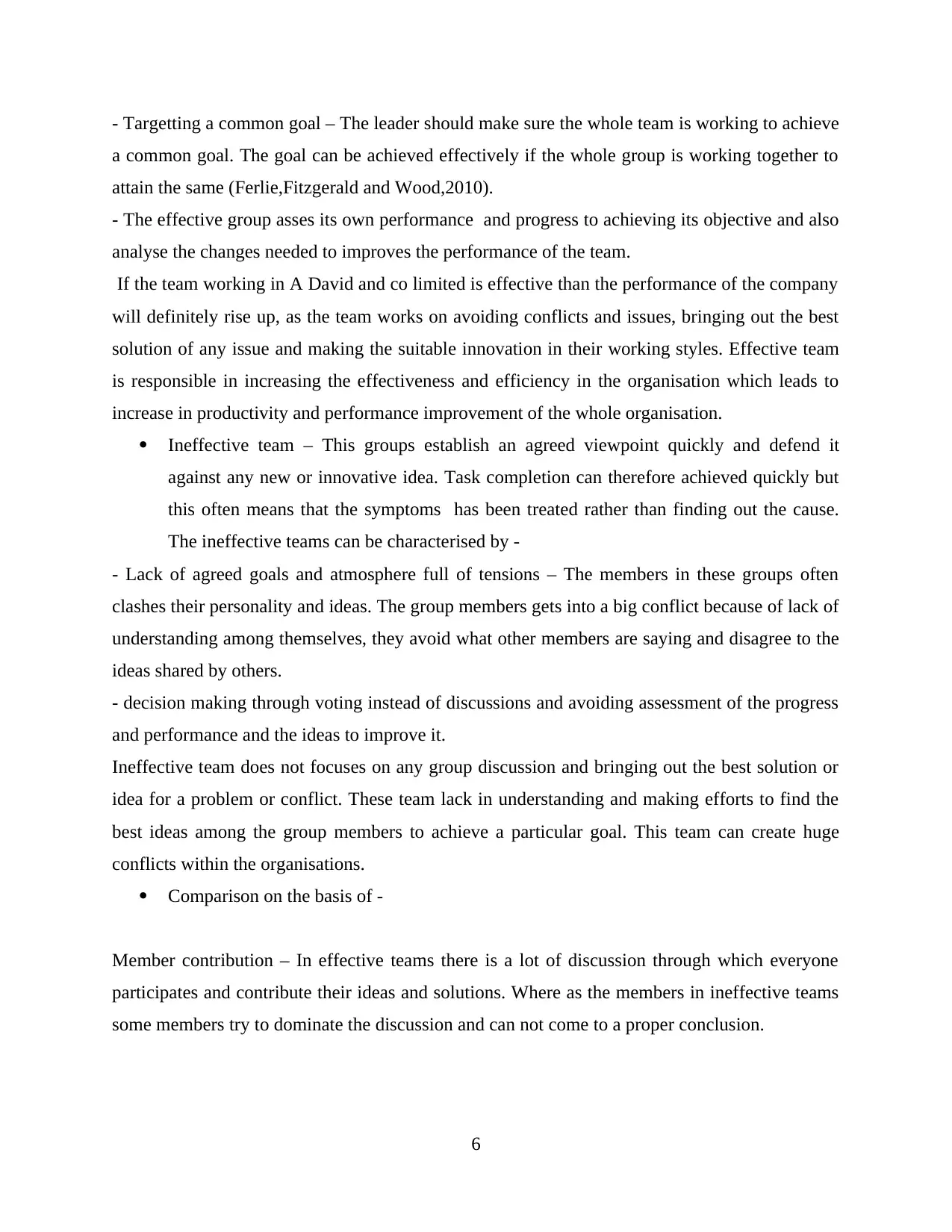
- Targetting a common goal – The leader should make sure the whole team is working to achieve
a common goal. The goal can be achieved effectively if the whole group is working together to
attain the same (Ferlie,Fitzgerald and Wood,2010).
- The effective group asses its own performance and progress to achieving its objective and also
analyse the changes needed to improves the performance of the team.
If the team working in A David and co limited is effective than the performance of the company
will definitely rise up, as the team works on avoiding conflicts and issues, bringing out the best
solution of any issue and making the suitable innovation in their working styles. Effective team
is responsible in increasing the effectiveness and efficiency in the organisation which leads to
increase in productivity and performance improvement of the whole organisation.
Ineffective team – This groups establish an agreed viewpoint quickly and defend it
against any new or innovative idea. Task completion can therefore achieved quickly but
this often means that the symptoms has been treated rather than finding out the cause.
The ineffective teams can be characterised by -
- Lack of agreed goals and atmosphere full of tensions – The members in these groups often
clashes their personality and ideas. The group members gets into a big conflict because of lack of
understanding among themselves, they avoid what other members are saying and disagree to the
ideas shared by others.
- decision making through voting instead of discussions and avoiding assessment of the progress
and performance and the ideas to improve it.
Ineffective team does not focuses on any group discussion and bringing out the best solution or
idea for a problem or conflict. These team lack in understanding and making efforts to find the
best ideas among the group members to achieve a particular goal. This team can create huge
conflicts within the organisations.
Comparison on the basis of -
Member contribution – In effective teams there is a lot of discussion through which everyone
participates and contribute their ideas and solutions. Where as the members in ineffective teams
some members try to dominate the discussion and can not come to a proper conclusion.
6
a common goal. The goal can be achieved effectively if the whole group is working together to
attain the same (Ferlie,Fitzgerald and Wood,2010).
- The effective group asses its own performance and progress to achieving its objective and also
analyse the changes needed to improves the performance of the team.
If the team working in A David and co limited is effective than the performance of the company
will definitely rise up, as the team works on avoiding conflicts and issues, bringing out the best
solution of any issue and making the suitable innovation in their working styles. Effective team
is responsible in increasing the effectiveness and efficiency in the organisation which leads to
increase in productivity and performance improvement of the whole organisation.
Ineffective team – This groups establish an agreed viewpoint quickly and defend it
against any new or innovative idea. Task completion can therefore achieved quickly but
this often means that the symptoms has been treated rather than finding out the cause.
The ineffective teams can be characterised by -
- Lack of agreed goals and atmosphere full of tensions – The members in these groups often
clashes their personality and ideas. The group members gets into a big conflict because of lack of
understanding among themselves, they avoid what other members are saying and disagree to the
ideas shared by others.
- decision making through voting instead of discussions and avoiding assessment of the progress
and performance and the ideas to improve it.
Ineffective team does not focuses on any group discussion and bringing out the best solution or
idea for a problem or conflict. These team lack in understanding and making efforts to find the
best ideas among the group members to achieve a particular goal. This team can create huge
conflicts within the organisations.
Comparison on the basis of -
Member contribution – In effective teams there is a lot of discussion through which everyone
participates and contribute their ideas and solutions. Where as the members in ineffective teams
some members try to dominate the discussion and can not come to a proper conclusion.
6
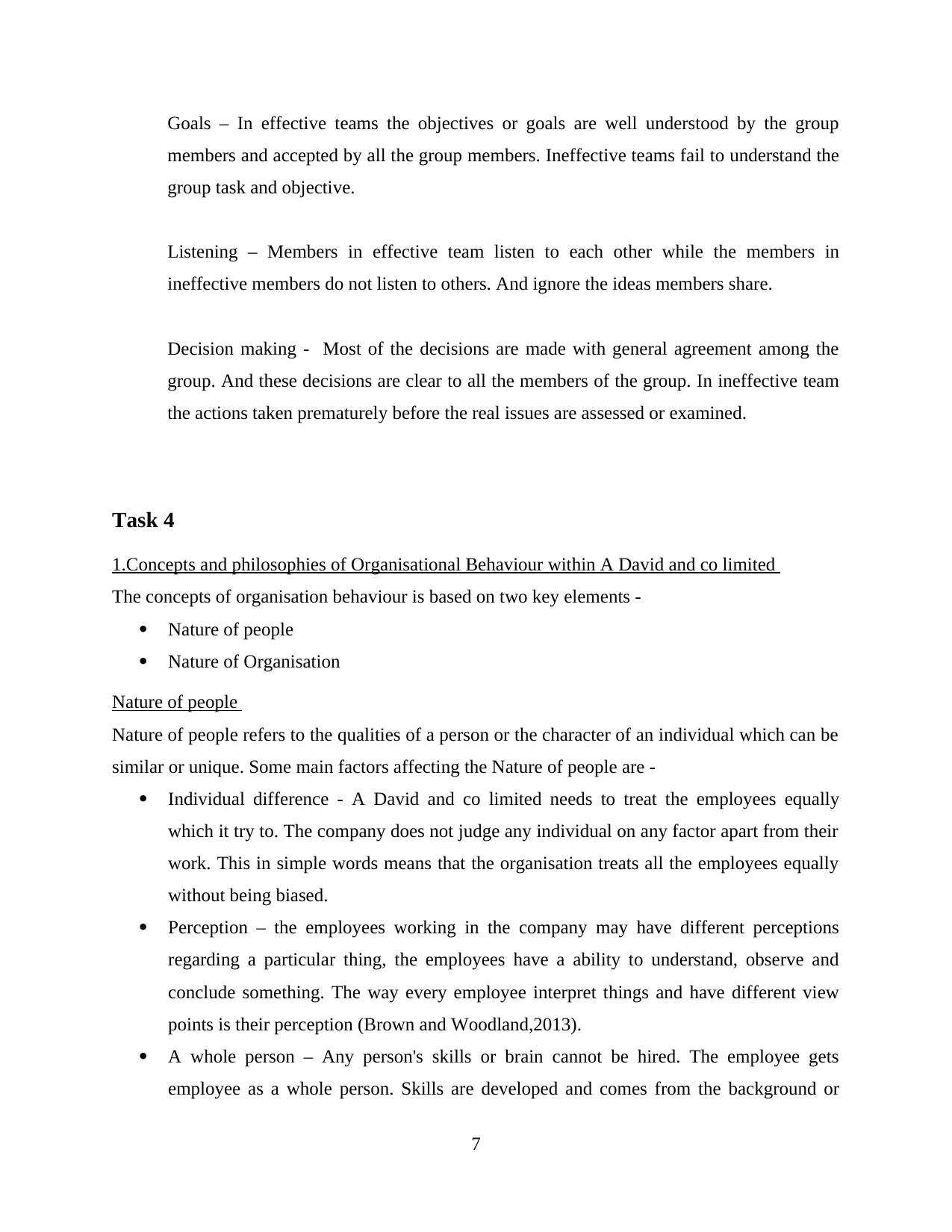
Goals – In effective teams the objectives or goals are well understood by the group
members and accepted by all the group members. Ineffective teams fail to understand the
group task and objective.
Listening – Members in effective team listen to each other while the members in
ineffective members do not listen to others. And ignore the ideas members share.
Decision making - Most of the decisions are made with general agreement among the
group. And these decisions are clear to all the members of the group. In ineffective team
the actions taken prematurely before the real issues are assessed or examined.
Task 4
1.Concepts and philosophies of Organisational Behaviour within A David and co limited
The concepts of organisation behaviour is based on two key elements -
Nature of people
Nature of Organisation
Nature of people
Nature of people refers to the qualities of a person or the character of an individual which can be
similar or unique. Some main factors affecting the Nature of people are -
Individual difference - A David and co limited needs to treat the employees equally
which it try to. The company does not judge any individual on any factor apart from their
work. This in simple words means that the organisation treats all the employees equally
without being biased.
Perception – the employees working in the company may have different perceptions
regarding a particular thing, the employees have a ability to understand, observe and
conclude something. The way every employee interpret things and have different view
points is their perception (Brown and Woodland,2013).
A whole person – Any person's skills or brain cannot be hired. The employee gets
employee as a whole person. Skills are developed and comes from the background or
7
members and accepted by all the group members. Ineffective teams fail to understand the
group task and objective.
Listening – Members in effective team listen to each other while the members in
ineffective members do not listen to others. And ignore the ideas members share.
Decision making - Most of the decisions are made with general agreement among the
group. And these decisions are clear to all the members of the group. In ineffective team
the actions taken prematurely before the real issues are assessed or examined.
Task 4
1.Concepts and philosophies of Organisational Behaviour within A David and co limited
The concepts of organisation behaviour is based on two key elements -
Nature of people
Nature of Organisation
Nature of people
Nature of people refers to the qualities of a person or the character of an individual which can be
similar or unique. Some main factors affecting the Nature of people are -
Individual difference - A David and co limited needs to treat the employees equally
which it try to. The company does not judge any individual on any factor apart from their
work. This in simple words means that the organisation treats all the employees equally
without being biased.
Perception – the employees working in the company may have different perceptions
regarding a particular thing, the employees have a ability to understand, observe and
conclude something. The way every employee interpret things and have different view
points is their perception (Brown and Woodland,2013).
A whole person – Any person's skills or brain cannot be hired. The employee gets
employee as a whole person. Skills are developed and comes from the background or
7
⊘ This is a preview!⊘
Do you want full access?
Subscribe today to unlock all pages.

Trusted by 1+ million students worldwide
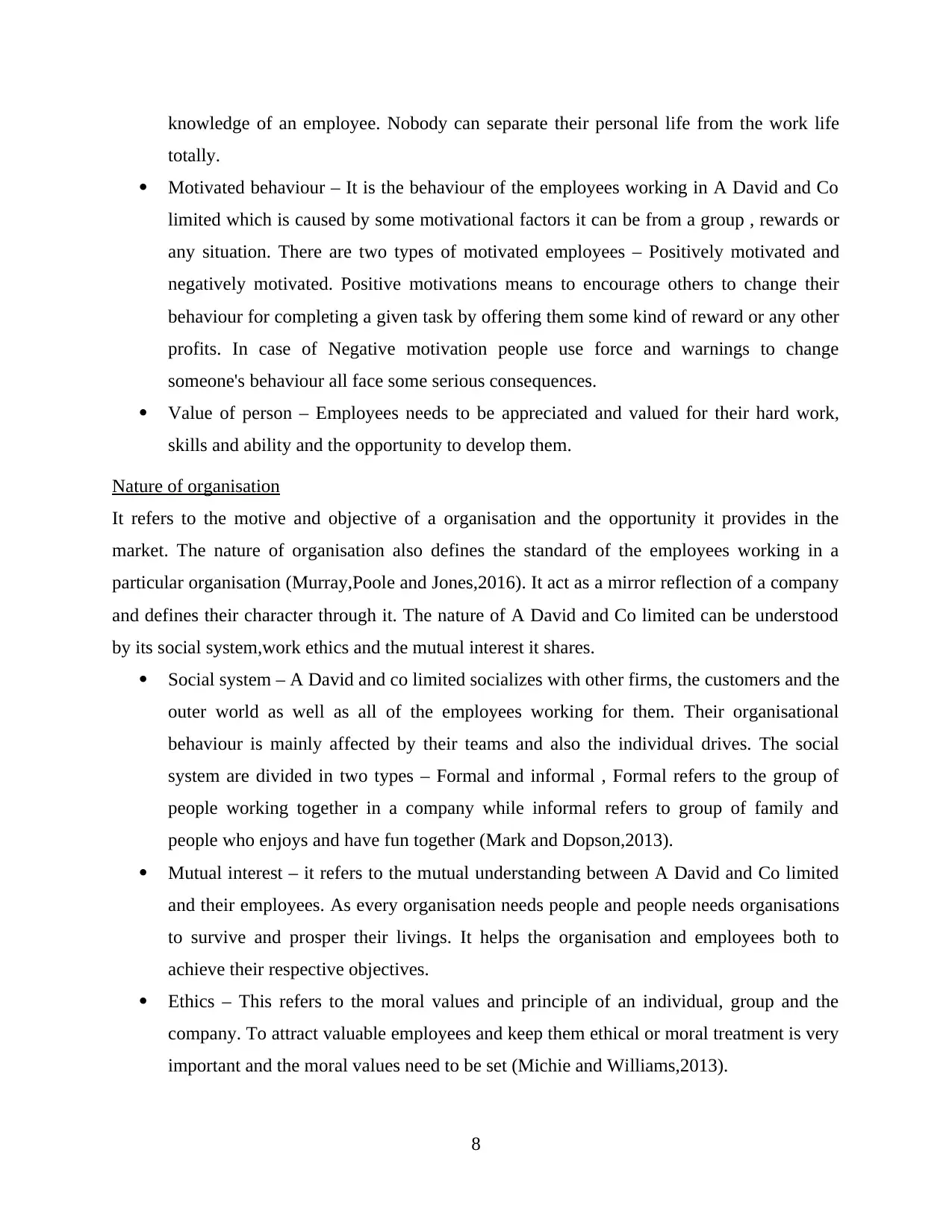
knowledge of an employee. Nobody can separate their personal life from the work life
totally.
Motivated behaviour – It is the behaviour of the employees working in A David and Co
limited which is caused by some motivational factors it can be from a group , rewards or
any situation. There are two types of motivated employees – Positively motivated and
negatively motivated. Positive motivations means to encourage others to change their
behaviour for completing a given task by offering them some kind of reward or any other
profits. In case of Negative motivation people use force and warnings to change
someone's behaviour all face some serious consequences.
Value of person – Employees needs to be appreciated and valued for their hard work,
skills and ability and the opportunity to develop them.
Nature of organisation
It refers to the motive and objective of a organisation and the opportunity it provides in the
market. The nature of organisation also defines the standard of the employees working in a
particular organisation (Murray,Poole and Jones,2016). It act as a mirror reflection of a company
and defines their character through it. The nature of A David and Co limited can be understood
by its social system,work ethics and the mutual interest it shares.
Social system – A David and co limited socializes with other firms, the customers and the
outer world as well as all of the employees working for them. Their organisational
behaviour is mainly affected by their teams and also the individual drives. The social
system are divided in two types – Formal and informal , Formal refers to the group of
people working together in a company while informal refers to group of family and
people who enjoys and have fun together (Mark and Dopson,2013).
Mutual interest – it refers to the mutual understanding between A David and Co limited
and their employees. As every organisation needs people and people needs organisations
to survive and prosper their livings. It helps the organisation and employees both to
achieve their respective objectives.
Ethics – This refers to the moral values and principle of an individual, group and the
company. To attract valuable employees and keep them ethical or moral treatment is very
important and the moral values need to be set (Michie and Williams,2013).
8
totally.
Motivated behaviour – It is the behaviour of the employees working in A David and Co
limited which is caused by some motivational factors it can be from a group , rewards or
any situation. There are two types of motivated employees – Positively motivated and
negatively motivated. Positive motivations means to encourage others to change their
behaviour for completing a given task by offering them some kind of reward or any other
profits. In case of Negative motivation people use force and warnings to change
someone's behaviour all face some serious consequences.
Value of person – Employees needs to be appreciated and valued for their hard work,
skills and ability and the opportunity to develop them.
Nature of organisation
It refers to the motive and objective of a organisation and the opportunity it provides in the
market. The nature of organisation also defines the standard of the employees working in a
particular organisation (Murray,Poole and Jones,2016). It act as a mirror reflection of a company
and defines their character through it. The nature of A David and Co limited can be understood
by its social system,work ethics and the mutual interest it shares.
Social system – A David and co limited socializes with other firms, the customers and the
outer world as well as all of the employees working for them. Their organisational
behaviour is mainly affected by their teams and also the individual drives. The social
system are divided in two types – Formal and informal , Formal refers to the group of
people working together in a company while informal refers to group of family and
people who enjoys and have fun together (Mark and Dopson,2013).
Mutual interest – it refers to the mutual understanding between A David and Co limited
and their employees. As every organisation needs people and people needs organisations
to survive and prosper their livings. It helps the organisation and employees both to
achieve their respective objectives.
Ethics – This refers to the moral values and principle of an individual, group and the
company. To attract valuable employees and keep them ethical or moral treatment is very
important and the moral values need to be set (Michie and Williams,2013).
8
Paraphrase This Document
Need a fresh take? Get an instant paraphrase of this document with our AI Paraphraser
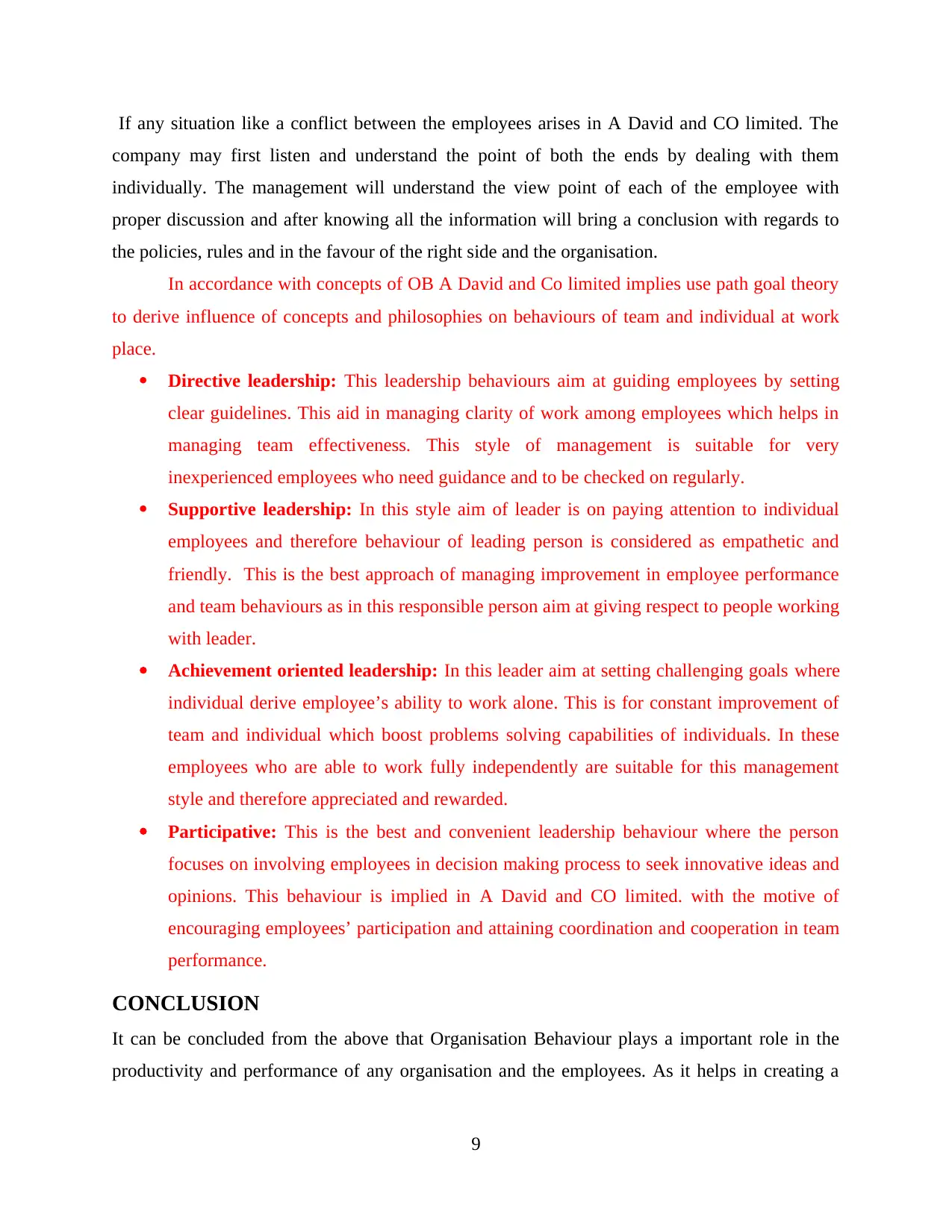
If any situation like a conflict between the employees arises in A David and CO limited. The
company may first listen and understand the point of both the ends by dealing with them
individually. The management will understand the view point of each of the employee with
proper discussion and after knowing all the information will bring a conclusion with regards to
the policies, rules and in the favour of the right side and the organisation.
In accordance with concepts of OB A David and Co limited implies use path goal theory
to derive influence of concepts and philosophies on behaviours of team and individual at work
place.
Directive leadership: This leadership behaviours aim at guiding employees by setting
clear guidelines. This aid in managing clarity of work among employees which helps in
managing team effectiveness. This style of management is suitable for very
inexperienced employees who need guidance and to be checked on regularly.
Supportive leadership: In this style aim of leader is on paying attention to individual
employees and therefore behaviour of leading person is considered as empathetic and
friendly. This is the best approach of managing improvement in employee performance
and team behaviours as in this responsible person aim at giving respect to people working
with leader.
Achievement oriented leadership: In this leader aim at setting challenging goals where
individual derive employee’s ability to work alone. This is for constant improvement of
team and individual which boost problems solving capabilities of individuals. In these
employees who are able to work fully independently are suitable for this management
style and therefore appreciated and rewarded.
Participative: This is the best and convenient leadership behaviour where the person
focuses on involving employees in decision making process to seek innovative ideas and
opinions. This behaviour is implied in A David and CO limited. with the motive of
encouraging employees’ participation and attaining coordination and cooperation in team
performance.
CONCLUSION
It can be concluded from the above that Organisation Behaviour plays a important role in the
productivity and performance of any organisation and the employees. As it helps in creating a
9
company may first listen and understand the point of both the ends by dealing with them
individually. The management will understand the view point of each of the employee with
proper discussion and after knowing all the information will bring a conclusion with regards to
the policies, rules and in the favour of the right side and the organisation.
In accordance with concepts of OB A David and Co limited implies use path goal theory
to derive influence of concepts and philosophies on behaviours of team and individual at work
place.
Directive leadership: This leadership behaviours aim at guiding employees by setting
clear guidelines. This aid in managing clarity of work among employees which helps in
managing team effectiveness. This style of management is suitable for very
inexperienced employees who need guidance and to be checked on regularly.
Supportive leadership: In this style aim of leader is on paying attention to individual
employees and therefore behaviour of leading person is considered as empathetic and
friendly. This is the best approach of managing improvement in employee performance
and team behaviours as in this responsible person aim at giving respect to people working
with leader.
Achievement oriented leadership: In this leader aim at setting challenging goals where
individual derive employee’s ability to work alone. This is for constant improvement of
team and individual which boost problems solving capabilities of individuals. In these
employees who are able to work fully independently are suitable for this management
style and therefore appreciated and rewarded.
Participative: This is the best and convenient leadership behaviour where the person
focuses on involving employees in decision making process to seek innovative ideas and
opinions. This behaviour is implied in A David and CO limited. with the motive of
encouraging employees’ participation and attaining coordination and cooperation in team
performance.
CONCLUSION
It can be concluded from the above that Organisation Behaviour plays a important role in the
productivity and performance of any organisation and the employees. As it helps in creating a
9
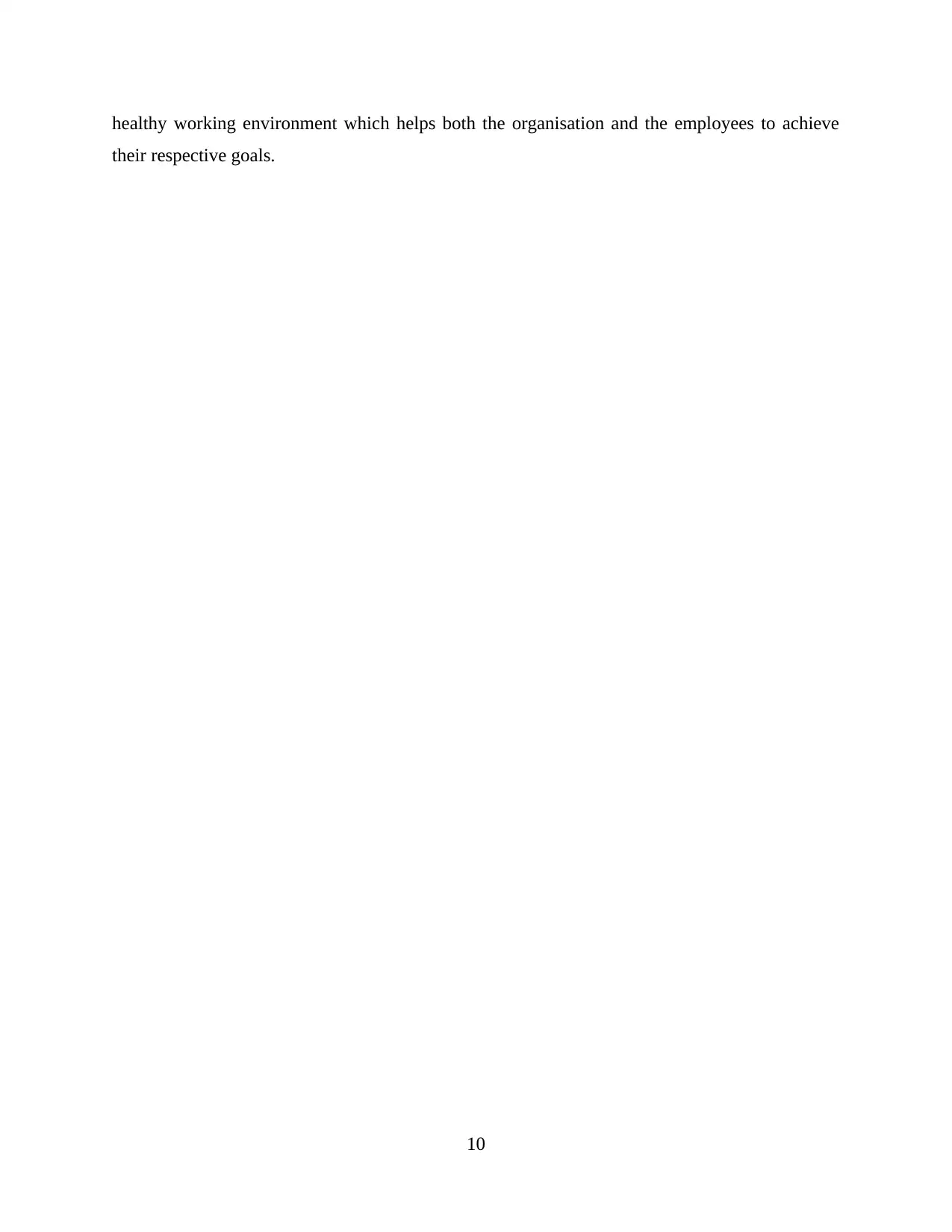
healthy working environment which helps both the organisation and the employees to achieve
their respective goals.
10
their respective goals.
10
⊘ This is a preview!⊘
Do you want full access?
Subscribe today to unlock all pages.

Trusted by 1+ million students worldwide
1 out of 14
Related Documents
Your All-in-One AI-Powered Toolkit for Academic Success.
+13062052269
info@desklib.com
Available 24*7 on WhatsApp / Email
![[object Object]](/_next/static/media/star-bottom.7253800d.svg)
Unlock your academic potential
Copyright © 2020–2025 A2Z Services. All Rights Reserved. Developed and managed by ZUCOL.





